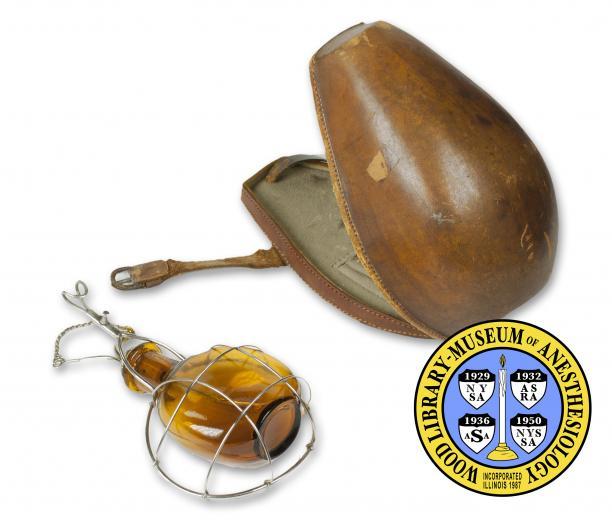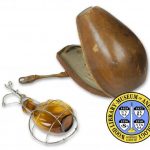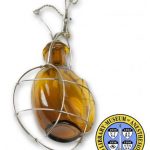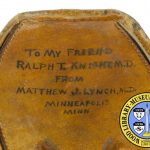Esmarch Inhaler
German surgeon Friedrich von Esmarch (1823-1908) introduced this inhaler in 1877. Cloth was stretched over the wire frame, providing a large surface for evaporation. Chloroform was dripped onto the cloth until the latter became saturated. More chloroform could be added as the agent evaporated. At the same time, the frame keeps the soaked cloth from touching the patient's face, preventing skin irritation. Packed together with a chloroform flask, gauze and a pair of scissors in a leather case with a shoulder strap, this was intended for use on the battlefield. Esmarch kits are believed to have been used by German military forces as late as World War II. The Esmarch mask was also popular for civilian use around the world, and was available in U. S. catalogs as late as the 1950s. Just as this was developed from an earlier invention, many later masks were modifications of the Esmarch. The most famous of these was the Schimmelbusch Mask.
Catalog Record: Esmarch Inhaler
Access Key: aikx
Accession No.: 230
Title: [Esmarch chloroform inhaler, cased / designed by Friedrich von Esmarch.]
Author: Esmarch, Johannes Friedrich August von, 1823-1908.
Title variation: Alt Title
Title: Esmarchís chloroform inhaler.
Title variation: Alt Title
Title: Esmarch’s chloroform set.
Title variation: Alt Title
Title: Esmarch chloroform kit.
Title variation: Alt Title
Title: Esmarch mask and case.
Publisher: [S.l. : s.n., 1877-1929.]
Physical Description: 1 anesthesia kit : silver plated brass[?], glass, cork ; 17.5 x 11.5 x 6.5 cm.
Subject: Masks, Anesthesia – wire frame.
Subject: Anesthesia, Inhalation.
Subject: Military Medicine.
Subject: Chloroform.
Subject: Ether, Ethyl.
Subject: Bottles.
Note Type: General
Notes: Title from the WLM name for the kit.
Note Type: Citation
Notes: Duncum BM. The Development of Inhalation Anaesthesia. London: Royal Society
of Medicine Press, 1994:249-251.
Note Type: Citation
Notes: Esmarch F. Handbuch der Kriegschirurgischen Technik. Hannover: Carl R¸mpler,
1877:113.
Note Type: Citation
Notes: Maltby JR. Notable Names in Anaesthesia. London: Royal Society of Medicine
Press, 2002:60-62.
Note Type: Physical Description
Notes: Portable anesthesia kit consists of a wire frame mask, chloroform dripping
bottle, and leather carrying case; The mask is approximately 17.5 x 11.5 x 6.
5 cm; The rim of the mask forms a rounded outline for the mouth and a
narrower ‘neck’ for the nose, with a curved handle at the upper end; When on
the patientís face, the handle sits on the forehead and can be used with a
band around the patientís head to keep the mask in place; Four metal bars
curve away from the face to form the distal side of the mask, and act to hold
the anesthetic soaked gauze away from the nose and mouth; The chloroform
bottle is made of amber colored glass and has a rounded body and narrow neck;
The bottle-top is metal and cork, with two metal tubes protruding out through
the top; Only one tube protrudes inside the bottle; This inner tube is curved
and almost reaches the bottom of the bottle; A pin and cap on a chain are
used to close off the tubes; The leather case is shaped to compactly carry
the chloroform bottle, and mask with gauze; The case measures approx. 17.5 x
11.5 x 6.5 cm; There are two small pockets inside the case that can hold
instruments for managing the airway (but are not included in this kit), such
as tongue forceps; Two leather straps with buckle closure hold the case shut;
Handwritten on the hinged door of the case is, “To my friend Ralph T. Knight,
M.D. From Matthew J. Lynch M.D. Minneapolis, Minn”.
Note Type: Reproduction
Notes: Photographed by Mr. William Lyle, 7/15/2010; In order to present an image of
the apparatus in the best state possible, this example was photographed with
a chloroform bottle not original to the mask and case pair.
Note Type: Acquisition
Notes: Donated to the WLM by Ralph T. Knight, M.D.
Note Type: Historical
Notes: Friedrich von Esmarch was a German surgeon and inventor. After developing the
mask from a modified Thomas Skinner wire-framed mask, Esmarch had chloroform
anesthesia kits created for portability and military surgery (Duncum, 1994;
Maltby, 2002). An image of the chloroform bottle in use can be viewed in
Esmarchís 1877 text, “Handbuch der Kriegschirurgischen Technik.” Duncum
provides an image of the leather-case, with its contents tucked inside, on
page 205 (1994). Esmarch is also well known for his compression bandage used
for surgery on the extremities and with Bierís intravenous regional analgesia
technique (Maltby, 2002). These kits were used in World War I and II.
Note Type: Publication
Notes: Esmarch, F von. The Surgeonís Handbook. New York: Sampson Low and Marston Co.
1896:145.




